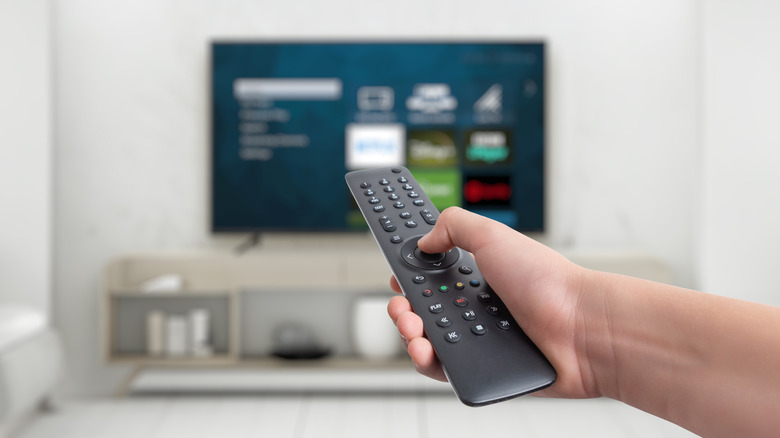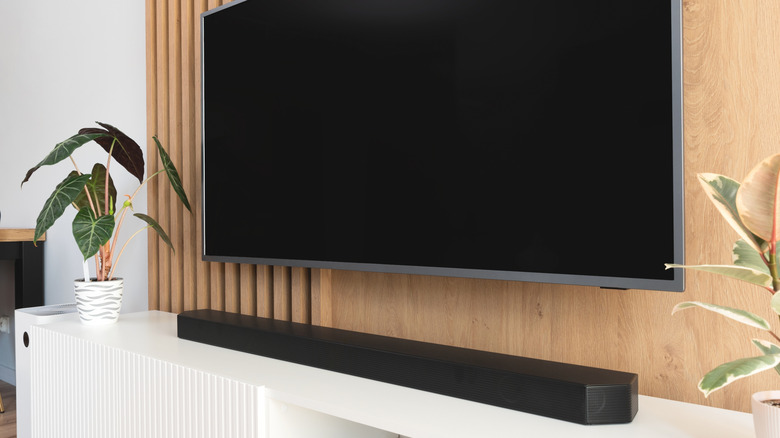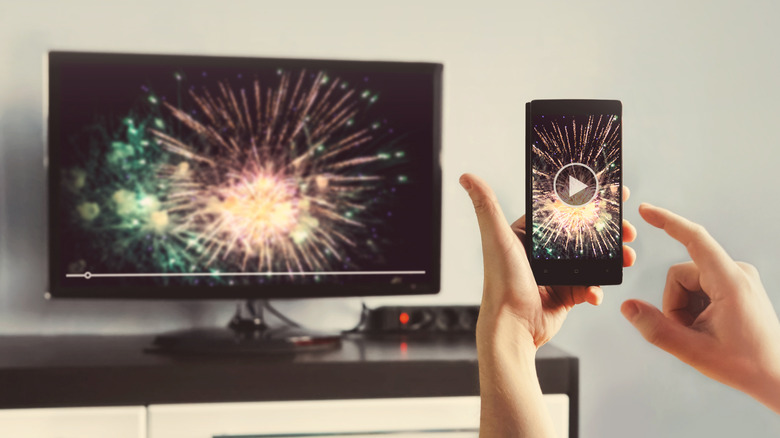9 Devices That Connect To Your Smart TV Without An HDMI Cable
HDMI is far and away one of the most popular types of connections for smart TVs. Capable of transmitting video and audio data through just one cable, you'll be hard-pressed to find a QLED or OLED TV that doesn't include at least two HDMI ports, with some models featuring three or four. But don't forget about the devices that plug into our TVs without an HDMI cable. There was a time when we wired cable boxes and AV components into the TV using RCA and coaxial connections.
Whether you were going the composite route — red and white for audio, yellow for video — or using more expensive component video cables to get the best picture possible, the pre-HDMI age was more cluttered from a wiring perspective. Though HDMI ports are more common on today's smart TVs, we still use devices that employ alternative connections. From soundbars and old-school VCRs to laptops and smartphones, these devices can all be connected to your smart TV without an HDMI cable.
Soundbars and headphones
With built-in drivers and woofers, a soundbar can deliver rich, room-filling sound that your TV alone can't match, and setup is usually as simple as connecting a single wire. Many soundbars connect to your TV using a digital optical cable. Both the TV and soundbar require a square-shaped port for this cable, and the wire itself emits a red light. A digital optical connection does an excellent job of transmitting audio, often supporting up to a 5.1-channel surround-sound signal, making it a reliable choice for most home theater setups.
That said, digital optical cannot transcode more complex audio formats like Dolby Atmos. For a soundbar to play back these hi-res codecs, you'll need an HDMI cable with audio-return capabilities (that's what the HDMI ARC port on your smart TV is for). Depending on your soundbar and TV, you may also have the option to connect using a 3.5 mm auxiliary cable, the same type used for most wired headphones.
It's a quick, affordable way to route audio from your TV to your soundbar, but keep in mind that auxiliary connections only support stereo sound. As for headphones, if the cable is long enough to stretch from your TV to the couch, you can plug wired headphones directly into your smart TV for private listening. And if your TV supports Bluetooth, you may even be able to connect your headphones wirelessly for a cable-free experience.
External storage devices
There are plenty of ways to make use of your TV's USB port, but one convenient feature for audio and video playback is the ability to connect an external storage device — like a USB flash drive or external SSD — to play your own media directly from the living room TV. Most smart TVs support a broad range of file formats, so playing video types like MP4 and AVI — or audio files such as MP3 and AAC — typically isn't an issue.
Compatibility will vary depending on the model and release year, but even entry-level sets from some of the most popular TV brands like Samsung usually handle a wide variety of media files with ease. If your TV supports video and audio playback through USB, it likely handles common image formats like JPEG and PNG as well, letting you turn your screen into a digital photo frame. Conveniently, most external storage drives are plug-and-play when it comes to TV media playback. Just be sure your device is up to date with the latest firmware or software before plugging it into your smart TV's USB port.
Antennas, VCRs, and DVD players
Older AV gear like VCRs, DVD players, and antennas typically relied on RCA and coaxial connections to link up with your TV. While most manufacturers have moved away from these analog inputs, some modern TVs still include a coaxial port — primarily for connecting an HD antenna. Once plugged in, you'll need to go into your TV's settings and run a scan for local channels. If you've still got an old VCR lying around that you'd like to fire up, there's a decent chance it uses a coaxial connection.
In that case, you can simply run a coaxial cable from your VCR to your TV. The picture and sound quality won't be stellar, but it's an easy and reliable way to bring your vintage equipment back to life. Some VCRs and DVD players also rely on RCA outputs to connect to a TV. While most modern sets have phased out built-in RCA ports, certain models work with RCA adapters that plug into a dedicated input on the back of your smart TV — making it possible to hook up legacy devices without much hassle.
Laptops, smartphones, and tablets
While devices like laptops can connect to a smart TV with an HDMI cable, wireless streaming is more common today. Most modern smart TVs include built-in support for popular platforms like Apple AirPlay and Google Cast, making it easy to mirror or stream content from smartphones, tablets, and laptops without extra hardware. For those without access to AirPlay or Google Cast, some devices — including Microsoft's Surface lineup — still support Miracast, a wireless screen-mirroring standard that's compatible with a wide range of smart TVs.
However, Miracast might be listed under a different name in your smart TVs settings. For instance, Samsung calls its casting feature Smart View, while other brands use labels like Screen Share or simply Screen Mirroring. Just make sure your laptop, phone, or tablet — and your smart TV — are connected to the same Wi-Fi network for these wireless mirroring features to work. It's also wise to keep all devices updated with the latest software, and you may need to approve a pairing request the first time you connect.




